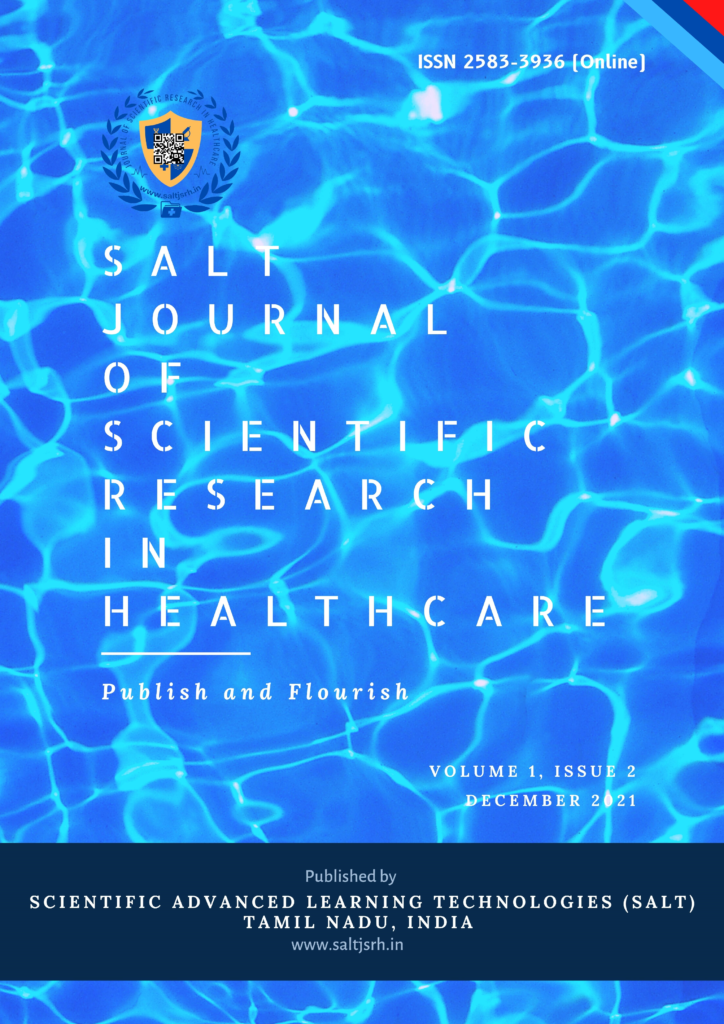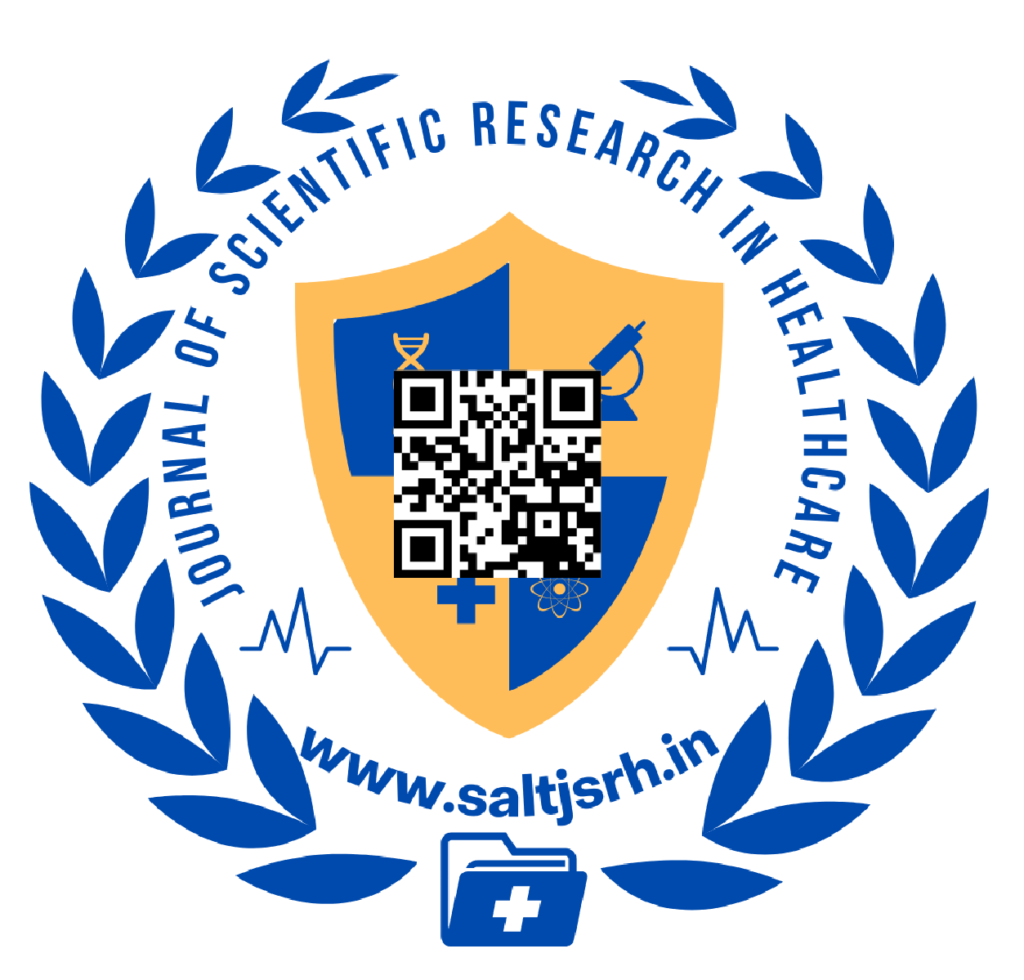THERAPEUTIC EFFECTS OF CUPPNG THERAPY IN FROZEN SHOULDER: A REVIEW ARTICLE
SALT Journal of Scientific Research in Healthcare
Volume 1, Issue 2, Page 35-37, Published on 02nd November 2021
https://doi.org/10.56735/saltjsrh.ms2101023537
Review Article
Department of Physiotherapy, Sharda University, Greater Noida 201306, India.
Corresponding Author: Rita Sharma, Assistant Professor, Department of Physiotherapy, Sharda University, Greater Noida 201306, India.
ORCID ID: 0000-0002-3788-8977
Email: rita.sharma@sharda.ac.in
ABSTRACT
Frozen shoulder is a chronic aseptic inflammation caused by injury and degeneration of shoulder capsule and periarthritic soft tissue (including ligaments, muscles, tendons, synovial sacs, etc.). Cupping is gaining popularity in physical medicine due to its ease of use, lack of side effects, and pain relief. This study looked at the efficacy of cupping therapy for treating shoulder pain. However, because very little literature on the efficacy of cupping therapy in the frozen shoulder is available, further research is needed in this field.
Keywords: Cupping therapy, frozen shoulder, adhesive capsulitis, wet cupping therapy, dry cupping.
INTRODUCTION
Frozen shoulder is a chronic aseptic inflammation caused by injury and degeneration of shoulder capsule and periarthritic soft tissue (including ligaments, muscles, tendons, synovial sacs, etc.). Shoulder and arm pain, as well as limited movement, were the most prominent clinical characteristics. The aetiology and pathogenesis of this condition are unknown; however it affects mostly middle-aged and elderly adults over the age of 40 1. Cupping is a simple application of quick, powerful, rhythmical strokes to activate muscles that can help with aches and pains caused by a variety of illnesses. As a result, cupping has the ability to improve one’s quality of life. “Cupping therapy are available in a variety of forms, the most prevalent of which are dry and wet cupping.
Wet measuring rips some skin to draw blood further into cup, but dry cupping forces the skin into the cup without scarifications”2.
METHOD OF APPLICATION OF CUPPING THERAPY
Cupping therapy includes putting tiny round glass, bamboo, ceramic, or plastic cups over the painful spot. A curled rim of the cup ensures close contact with the skin, preserving the negative pressure caused. At the ideal location, the cup’s mouth is firmly pushed on the skin. Heat and other vacuums, such as manual pumps, are used to produce negative pressure. The cup is held on the skin by negative pressure, which creates a suction force that pushes the skin into the cup. Lubricants may be used by the therapist to assist the cups to move more easily and cover a broader area. The back, chest, belly, buttocks, and other muscle-rich regions are typical application locations.
In the majority of cases, the cups are kept in place for 5 to 20 minutes. Erythema, edoema, and ecchymosis are common side effects that last anywhere from a few days to a few weeks. The five key phases in the cupping treatment procedure are as follows:
“A scalpel blade (No. 15 to 21) is used to make incisions in the skin or by entering the skin with a needle, auto-lancing equipment, or a plum-blossom needle when moist cupping is employed”.
For 3–5 minutes, the cup is put on the skin again. The cup is taken away. A dressing is placed in the treated area after it has been washed and disinfected.
Following the therapeutic session, the bandage is normally retained for 48 hours. The cupping therapy region is disinfected by the therapist.
The therapist places a proper-sized cup on the appropriate region and uses suction to draw the air out of the cup.
3–5 minutes will be spent with the cup on the skin 3.
MECHANISMS OF ACTION
The effects of sub-atmospheric pressure suction, boosting peripheral blood circulation, and enhancing immunity were the major hypothesised mechanisms of action. Cupping treatment has been reported to improve skin blood flow, change biomechanical aspects of the skin, increase pain thresholds, improve local anaerobic metabolism, reduce inflammation, and modulate the cellular immune system 4.
METHODOLOGY
Different “keywords” and “Boolean Operators” were used to search databases such as PubMed, CINAH, Google scholar, etc. Databases were searched from 2015. Only those research papers were considered in the investigation, which has reported the effects of cupping therapy on shoulder pain. Research reports only written in English were included in the review process. Reports which included subjects with a neurological disorder or other chronic illness were not considered for the investigation. Case Reports and conference proceedings were also excluded.
Huang et al. (2016) combined cupping treatment with acupuncture and massage to treat the neck and shoulder areas. This therapy was given once a day for a total of one session. A whole course of therapy consists of five sessions, and the experiment involved a total of four courses. Their findings showed that this regimen might lessen shoulder discomfort considerably 5.
In 2016, Muzeyyen Arslan, Nurcan Gokgoz, and Senol Dane researched the effects of traditional wet cupping treatment (wct) on shoulder and neck pain and found that WCT had a likely restorative impact in the nonspecific neck and upper shoulder pain 6.
Moving Dry Cupping Therapy Reduces Upper Shoulder and Neck Pain in Office Workers was reviewed by Yaman, Gulnur, Esra, Murat, and Bahar (2015), who concluded that Cupping treatment is a harmless and innocuous remedial application that is unquestionably used to reduce upper shoulder and neck pain in office workers 7.
CONCLUSION
Cupping treatment can assist with low back pain, neck discomfort, and other musculoskeletal issues. However, there is very little literature on the effectiveness of cupping treatment in the treatment of frozen shoulder; thus so, further exploration is needed in this field.
REFERENCES
- Zhang LH, Wang LX, Cui Q, Zhang GW. Efficacy of blood-letting puncture and cupping in the treatment of periarthritis of shoulder: a systematic review. TMR Integrative Medicine. 2018; 2(4): 175-91. https://doi.org/10.12032/TMRIM201802033.
- Al-Bedah AMN, Elsubai IS, Qureshi NA, Aboushanab TS, Ali GIM, El-Olemy AT, Khalil AAH, Khalil MKM, Alqaed MS. The medical perspective of cupping therapy: Effects and mechanisms of action. J Tradit Complement Med. 2018 Apr 30;9(2):90-97. https://doi.org/10.1016/j.jtcme.2018.03.003. PMID: 30963043; PMCID: PMC6435947.
- Al-Shidhani A, Al-Mahrezi A. The Role of Cupping Therapy in Pain Management: A Literature Review. In: Waisundara, V. Y., Banjari, I., Balkić, J., editors. Pain Management – Practices, Novel Therapies and Bioactives [Internet]. London: IntechOpen; 2020 [cited 2022 Mar 01]. Available from: https://www.intechopen.com/chapters/73348; https://doi.org/10.5772/intechopen.93851.
- Tamer S Aboushanab and Saud AlSanad. Cupping therapy: an overview from a modern medicine perspective. J Acupunct Meridian Stud. 2018 Jun;11(3):83-87. https://doi.org/10.1016/j.jams.2018.02.001. Epub 2018 Feb 7.
- Chi LM, Lin LM, Chen CL, Wang SF, Lai HL, Peng TC. The effectiveness of cupping therapy on relieving chronic neck and shoulder pain: a randomised controlled trial. Evid Based Complement Alternat Med. 2016; 2016:7358918. https://doi.org/10.1155/2016/7358918. Epub 2016 Mar 17. PMID: 27073404; PMCID: PMC4814666.
- Arslan M, Gökgöz N, Dane Ş. The effect of traditional wet cupping on shoulder pain and neck pain: A pilot study. Complement Ther Clin Pract. 2016 May;23:30-3. https://doi.org/10.1016/j.ctcp.2016.02.003. Epub 2016 Feb 27. PMID: 27157955.
- Arslan M, Yaman G, Ilhan E, Alemdag M, Bahar A, Dane S. Moving dry cupping therapy reduces upper shoulder and neck pain in office workers. Clin Invest Med. 2015 Aug 1;38(4): e217-e220.
ARTICLE TYPE: Review Article;
ORCID ID: Open Researcher and Contributor Identifier (ORCID) ID of corresponding author: https://orcid.org/0000-0002-3788-8977;
ETHICAL: NA;
ACKNOWLEDGEMENT: None;
FINANCIAL DISCLOSURE: The authors declare that there was no financial aid received.;
CONFLICT OF INTEREST: No conflict of interest associated with this research work.;
AUTHORS CONTRIBUTION: R.S., reviewed and wrote the article for publication.;
CORRESPONDING AUTHOR AFFILIATIONS: Ms. Rita Sharma, Assistant Professor, Department of Physiotherapy, Sharda University, Greater Noida 201306, India.;
CORRESPONDING AUTHOR EMAIL: rita.sharma@sharda.ac.in;
ARTICLE CITATION: Sharma R. Therapeutic effects of cupping therapy in frozen shoulder: a review article. SALT J Sci Res Healthc. 2021 November 02; 1(2): 35-37.
PUBLISHER’S NOTE: All claims expressed in this article are solely those of the authors and do not necessarily represent those of their affiliated organizations, or those of the publisher, the editors and the reviewers. Any product that may be evaluated in this article, or claim that may be made by its manufacturer, is not guaranteed or endorsed by the publisher.




© Rita Sharma.
Originally published in the SALT Journal of Scientific Research in Healthcare (https://saltjsrh.in/), 02.11.2021.
This is an open-access article distributed under the terms of the Creative Commons License (https://creativecommons.org/licenses/by-nc-nd/4.0/), which permits unrestricted use, distribution, and reproduction in any medium, provided the original work, first published in the SALT Journal of Scientific Research in Healthcare (https://saltjsrh.in/), is properly cited. The complete bibliographic information, a link to the original publication on https://saltjsrh.in/, as well as this copyright and license information must be included.
